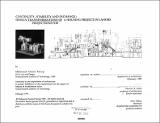| dc.contributor.advisor | Maurice K. Smith. | en_US |
| dc.contributor.author | Faruqi, Mahmood Ahmed | en_US |
| dc.contributor.other | Massachusetts Institute of Technology. Dept. of Architecture. | en_US |
| dc.coverage.spatial | a-pk--- | en_US |
| dc.date.accessioned | 2012-10-10T15:42:47Z | |
| dc.date.available | 2012-10-10T15:42:47Z | |
| dc.date.copyright | 1989 | en_US |
| dc.date.issued | 1989 | en_US |
| dc.identifier.uri | http://hdl.handle.net/1721.1/73762 | |
| dc.description | Thesis (M. Arch.)--Massachusetts Institute of Technology, Dept. of Architecture, 1989. | en_US |
| dc.description | Includes bibliographical references (p. 113). | en_US |
| dc.description.abstract | The role of planner is something that post industrial society has thrust upon architects in the twentieth century. Whereas previously they were limited mostly to the design of singular special buildings for the environment, architects now suddenly find themselves in the position of, and with the responsibility for, dealing with large projects whose size entails the design less of buildings than of new (inhabitantable) physical landscapes. It becomes obvious after looking at the attempts made towards these ends that in the design of these projects conventional and accepted contemporary forms of order do not seem to be sufficient to address the issues of scale, growth, adaptability and multiplicity that any reasonable built environment requires to survive and flourish .Structures of form and I or space based on uniform distributions or on singular ideas are found to be either too rigid or too neutral 1 and in both cases lacking the support which can be intensified and built upon to allow the development of a~sociations with place. Alternative systems of order are required if unity and diversity as well as flexibility and stability are to be inclusively built into our new environments so that they can not only survive but flourish. This thesis proposes that space is the essence, both as medium and result, of architectural form; it is an exploration of an alternative order in architecture based on the structuring (building) of space as a primary organizing principle in design. Interpreted (built or otherwise inhabitable) physical landscapes, which present us with similar patterns of order and growth, as well as the works of architects working with a like understanding of space, are used as primary references with an attempt to understand the complexity of these environments, particularly the structuring of space I in terms of the basic formal concepts of continuity and stability (loosely translatable as movement and territory, 'space' and 'place', 'stop' and 'go', etc.) and exchange (which can be seen as the result of the interaction of the first two elements I and which in more reasonable environments is also the relationship between them). It is the premise of this study that richness and multiplicity in physical environments are direct results of 'built -space exchanges' ; that exchange provides the structure in the environment which can not only support inhabitation and allow for association and meaning I but also impart resilience and adaptability and become the vessel for nurturing growth and change. An order based on an understanding of, and a reasonable attitude towards, these primary principles of form behaviour is seen as a flexible method for the generation of design at different scales in a similar manner, and for the building of multiplicity and complexity at all sizes in a project, be it large or small. The transformation of an existing housing project in Lahore, Pakistan is the design exercise employed in this thesis to explore these issues of building exchange in the physical environment, using the concepts of continuity and stability. | en_US |
| dc.description.statementofresponsibility | by Mahmood Ahmed Faruqi. | en_US |
| dc.format.extent | 113 p. | en_US |
| dc.language.iso | eng | en_US |
| dc.publisher | Massachusetts Institute of Technology | en_US |
| dc.rights | M.I.T. theses are protected by
copyright. They may be viewed from this source for any purpose, but
reproduction or distribution in any format is prohibited without written
permission. See provided URL for inquiries about permission. | en_US |
| dc.rights.uri | http://dspace.mit.edu/handle/1721.1/7582 | en_US |
| dc.subject | Architecture. | en_US |
| dc.title | Continuity, stability and exchange : design transformations of/projections for a housing project in Lahore | en_US |
| dc.type | Thesis | en_US |
| dc.description.degree | M.Arch. | en_US |
| dc.contributor.department | Massachusetts Institute of Technology. Department of Architecture | |
| dc.identifier.oclc | 20448301 | en_US |
